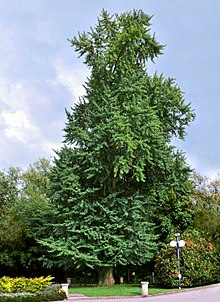Ginkgo biloba

Ginkgo biloba, commonly known as ginkgo or gingko[4] (both pronounced /ˈɡɪŋkoʊ/), also known as the maidenhair tree,[5] is a species of tree native to China. It is the only living species in the order Ginkgoales, which first appeared over 290 million years ago. Fossils very similar to the living species, belonging to the genus Ginkgo, extend back to the Middle Jurassic approximately 170 million years ago.[2] The tree is widely cultivated, and was cultivated early in human history.
The genus name Ginkgo is regarded as a misspelling of the Japanese gin kyo, “silver apricot”,[6] which is derived from the Chinese 銀杏 used in Chinese herbalism literature such as Materia Medica (日用本草 (1329) appearing at volume 6, page 8) and Compendium of Materia Medica (本草綱目 (1578)).[7]
Despite its complicated spelling, which is due to an exceptionally complicated etymology including a transcription error, “ginkgo” is usually pronounced /ˈɡɪŋkoʊ/,[4] which has given rise to the common other spelling “gingko”. The spelling pronunciation /ˈɡɪŋkɡoʊ/ is also documented in some dictionaries.[8][9]
Engelbert Kaempfer first introduced the spelling ginkgo in his book Amoenitatum Exoticarum.[10] It is considered that he may have misspelled “Ginkjo” as “Ginkgo”. This misspelling was included by Carl Linnaeus in his book Mantissa plantarum II and has become the name of the tree’s genus.[4]
